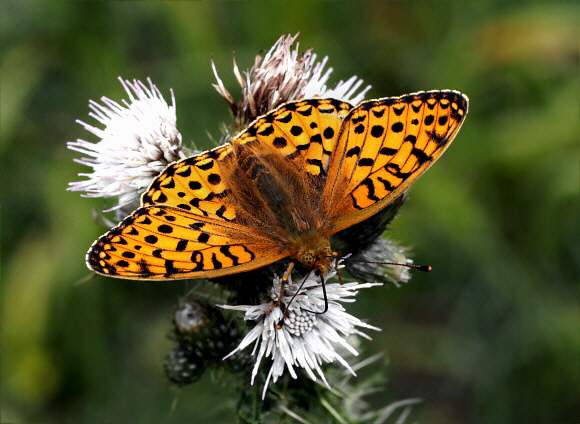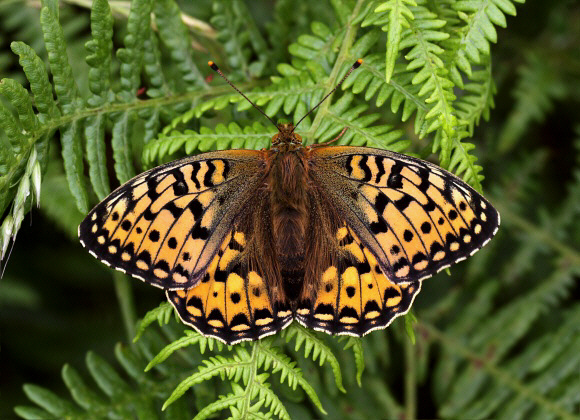
Introduction
The genus Argynnis comprises of about 25 species, found variously in Europe, temperate Asia and North America. Certain workers include an additional 18 Speyeria species within Argynnis.
The Dark Green Fritillary, formerly known as the Queen of England Fritillary is widely distributed across Europe but absent from most Mediterranean islands. It is also found throughout temperate Asia as far east as Japan, and occurs in the Atlas mountains of Morocco.
The common name refers to the bronzy-green underside wings, which are spangled with large silver spots.
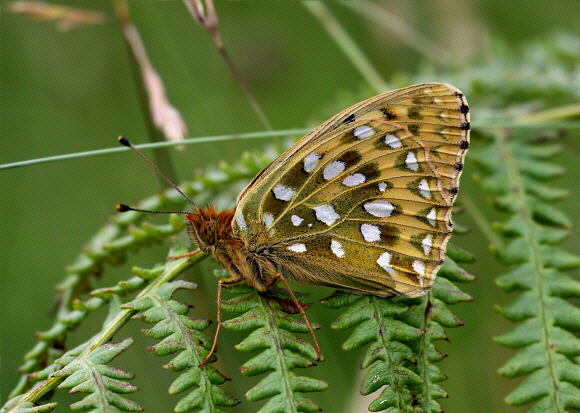
The upperside wings of males are bright unicolorous orange, with black spots. Females are variable in ground colour, some being a dull reddish brown ground colour while others have a distinct bronzy sheen. In females the colour is often paler near the apex and wing margins, while the basal area of the forewings is noticeably dark. In Scotland both sexes tend to be larger and more heavily marked than elsewhere in the butterfly’s range.
The butterfly can easily be confused with the High Brown Fritillary Argynnis adippe, but the male of that species has short wide sex brands on veins 2 and 3 ( as opposed to the long narrow brands on veins 1, 2 and 3 in aglaia ). The High Brown Fritillary also has slightly concave outer margins to the forewings. On the underside adippe has a more yellowish ground colour, and an additional band of small silver sub-marginal spots that are ringed with dark red.
On Corsica the Dark Green Fritillary is absent, being replaced by the endemic Argynnis elisa, which is very similar to aglaia but is smaller and has greatly reduced black markings on the upperside.
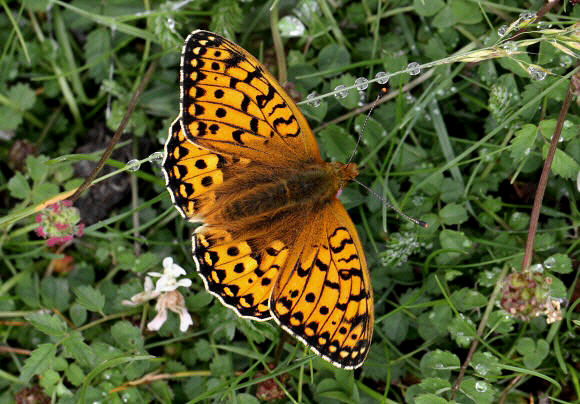
Habitats
This is the most widespread and least threatened of Fritillaries in Britain. In southern England it is a butterfly of wild, windswept open grasslands and cliff-tops, but also occurs on heathlands, dunes and in forest clearings. In northern counties it is found on moors and mountain valleys and can also be found in the company of the High Brown Fritillary in grassland / woodland mosaics on limestone.
In Scotland the butterfly is found on moors and mountainsides, in woodlands, and on open grassy habitats. It is the only Fritillary which occurs on the windswept islands of the Orkneys and Outer Hebrides.
Although it is very widespread and utilises a very broad range of habitats, populations are localised with very little movement between sites. They also tend to be confined to particular areas of each site, often restricted to sheltered pockets where the soil is deep, and violets grow in large clumps.
European populations are far less restricted by habitat, being found in lowland meadows, limestone gorges, sub-alpine hay meadows and many other habitats.
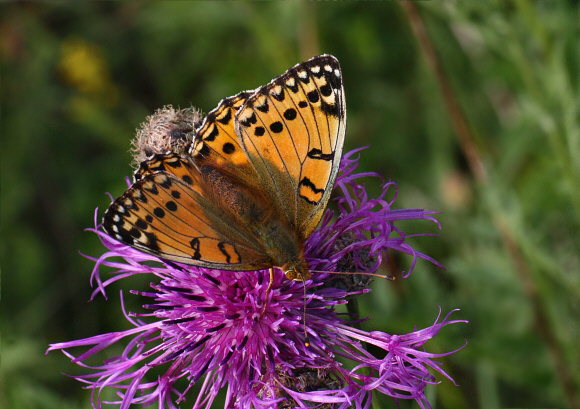
Lifecycle
The eggs are straw coloured with purplish bands. They are laid in July or early August on leaves or stems in the vicinity of the larval foodplants, but not usually on the foodplant itself. At Dean Hill in July 2007 for example I observed a female enter a clump of dead grasses and twigs, upon which she laid 6 eggs dotted about on different stems over a period of 2 or 3 minutes. Violet plants Viola hirta were profuse in the area, the nearest plant being about a metre from the oviposition site.
At chalk and limestone grassland sites the usual foodplant is hairy violet Viola hirta, but in southern woodlands common dog violet V. riviniana is normally used. On heaths in the New Forest, and on moors in Cumbria and Scotland, V. palustris is favoured.
The larvae hatch in August, about 16 days after the eggs are laid. After eating the empty egg-shells they immediately enter hibernation. They over-winter in curled up dead leaves, or in chinks on the bark of bushes. The following March they awaken to feed on violet leaves, nibbling large chunks out of the lobes. In southern England they become fully grown in early May. In Scotland I’ve often found fully grown larvae wandering across country roads as late as the first week of June.
When fully grown they are mottled in black and grey, adorned along the back and sides with rows of branched black spikes, and have a yellow stripe along the back. There is a row of dark reddish spots low down on the sides, and the head is black and glossy.
The chrysalis is shiny, with black wing-cases and a dark brown abdomen. I have found it in the wild in Scotland formed amongst bracken and leaf litter, suspended by the tail from a dry stem, and protected amongst a cluster of dead leaves spun together with silk.

Adult behaviour
At grassland sites in southern England the butterflies nectar on knapweeds, almost to the exclusion of other flowers, but in woodland they will feed at bramble, spear thistles, bird’s foot trefoil, clovers, buddleia and hawkbit. They usually spend several seconds nectaring at each flower before flying rapidly to another plant perhaps 100 metres distant, even if other flowers are situated nearby.
Dark Green Fritillaries are extremely alert, agile and powerful on the wing, and seem to relish flying in the face of the strong breezes which prevail at their open windswept habitats. In rainy weather they crawl deep into grass tussocks but they still remain very alert – the tiniest disturbance causes them to fly up instantly, dashing off in search of a new resting place.
Throughout the day males patrol relentlessly back and forth across their habitat, soaring effortlessly in the face of the strongest winds. They dip down periodically, searching for females, which sit deep in grass tussocks prior to mating. Once a female is located, copulation takes place immediately with no apparent courtship ritual. Mated pairs occasionally fly in tandem to nectar at flowers, but spend most of the time sitting hidden among the grasses, with the wings held erect or half open.
In overcast or cool conditions the butterflies often remain fairly active, but spend long periods basking in rabbit scrapes, patches of bare earth, or amongst grasses. At Martin Down in Hampshire I once discovered a male Dark Green Fritillary which had settled to bask on a coiled grass snake !
Shortly before dusk on sunny days, the butterflies migrate across their habitat to bask in the last remaining sunlit areas, and can often be seen in the company of Marbled Whites, soaking up the last rays of the sun. As the sun dips below the horizon, they undertake a final flight to locate a roosting site – often this can be high in a tree, but more frequently they roost hanging from grass heads in areas where the grasses grow tall, or on low bushes of dogwood or buckthorn.
